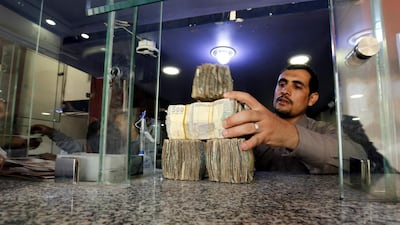Hundreds of Yemenis took to the streets in Aden yesterday, angered at a sharp fall in the value of the rial and the deteriorating economy.
Exchange houses have been valuing the US dollar at markedly higher levels in recent days, making imports more expensive.
The value of the Yemeni rial dropped sharply as a result of the war and the Houthi looting of the central bank before President Abdrabu Mansur Hadi moved it to Aden in 2016.
The Arab Coalition – which includes Saudi Arabia and the UAE – fighting the rebels in Yemen has repeatedly raised the alarm that the Houthis threaten vessels in the Red Sea, a key shipping route for world trade, through their control of the strategic Hodeidah port.
The Bab Al Mandab, one of the world’s busiest shipping routes, is the southern entrance to the Red Sea and has become an increasing focus of Houthi attacks as the three-year conflict has caused the rebels’ footprint to shrink under pressure from pro-government forces.
Arab Coalition states have injected deposits into Yemen’s Central Bank to prop up the war-battered economy, which has suffered chronic crises over the past eight years.
In March, the Yemeni rial rose by nearly 10 per cent against the dollar after Saudi Arabia signed an agreement with the Yemen Central Bank for the transfer of $2 billion (Dh7.35bn) to ease economic pressures.
But yesterday’s protests came after a call from activists for civil disobedience against the currency’s recent slide against the dollar and other foreign currencies.
The rial has fallen sharply against the dollar over the past three months. In July, it was valued at 496 to 1 US dollar but last Tuesday it traded at 570 and then fell to between 600 and 610 yesterday, according to traders at the Al Amri exchange centre in Aden.
“I am here to tell the region and the world that we are starving, I am here to express myself independently, away from politics. I want bread, water and electricity and the price of the local currency to get back to its level in 2014,” Mohammed Khan, a young protester from Aden, told The National. The protestors blocked roads and burnt tyres, also making their presence felt outside government offices where they chanted slogans.
Women and children as well as state employees also took part in the protests in Aden.
“My salary used to be worth about $400 but today it’s about $200 because the Yemeni rial became nothing against the dollar,” an employee from the University of Aden told The National.
With the country at war there have also been problems in paying state employees’ salaries.
UN Special Envoy Martin Griffiths will mediate between the Yemeni government and the Iran-backed Houthi rebels at talks in Geneva later this week. It is the biggest effort at peace since 2016.
The use of further UN intermediaries, rather than face-to-face talks, follows the same pattern as the UN’s peace talks in Syria.
It is designed to ensure that progress, however limited, can be made.
The Yemen discussions will primarily focus on the Houthi-held port city of Hodeidah, the disarming of all non-government forces and a possible exchange of prisoners.
Houthi rebels have asked for political recognition and to retain control over some areas of the country.
___________
Read more:
Arab coalition expresses regret for 'mistakes' in Yemen strike
US seizes major weapons cache from boat in Gulf of Aden
___________

